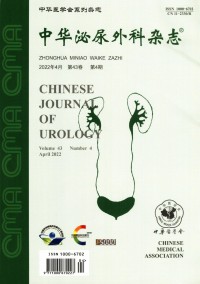Survival and prognostic analysis of adult nonclear cell renal cell carcinoma
Q4 Medicine
引用次数: 0
Abstract
Objective To analyze the prognostic factors of adult nonclear cell renal cell carcinoma (nccRCC). Methods The clinical data of 286 patients with pathologically diagnosed one specific type of nccRCC after radical nephrectomy and nephron sparing surgery(NSS) in the affiliated hospital of Qingdao university followed up from January 2012 to January 2019 were retrospectively analyzed.There were 159 males and 127 females. Their age ranged from 17 to 81 years old, with an average age of 53. Based on the AJCC combination stage, 218 cases were in stage Ⅰ, 56 cases were in stage Ⅱ, 9 cases were in stage Ⅲ, 3 cases were in stage Ⅳ. Assay indicators were collected, including lymphocyte percentage(LY%)(31.5±10.5), neutrophil-lymphocyte ratio(NLR)(2.6±2.8), albumin(40.9±4.7)g/L, prealbumin(255.0±74.3)mg/L, lactate dehydrogenase (LDH)(201.0±174.0)U/L, creatine kinase isoenzyme (CK-MB)(20.0±62.1)U/L, total cholesterol(4.9±1.0)mmol/L, blood urea nitrogen/creatinine (BUN/Cr)(12.9±9.9), blood glucose(5.4±1.3)mmol/L, triglyceride(1.4±1.1)mmol/L, low-density lipoprotein cholesterol (LDL-C)(2.9±0.8)mmol/L. The optimal cut-off value of the above indexes were obtained by the receiver operating characteristic curve(ROC) in the SPSS software, and difference between high cut-off and low cut-off divided basing on the optimal cut-off value were evaluated respectively. The prognostic factors of adult nccRCC were evaluated by univariate and multivariate Cox proportional hazards regression analysis. Kaplan-Meier survival curve was used to study the survival relationship. The log-rank test were used to compare survival rate in two groups. The prognostic factors of nccRCC were analyzed after the results above were presented. Prognostic factors in renal chromophobe cell carcinoma and papillary cell carcinoma were analyzed by the same method. Results The 286patients were followed up from 1 to 87 months, with an average of 43.9 months. The 3-year and 5-year survival rates were 93.8% and 89.3%, respectively. Results of univariate and multivariate Cox regression model revealed that AJCC combined staging (HR=2.38, 95%CI1.48-3.83), LDH(HR=2.99, 95%CI1.16-7.69), blood glucose (HR=4.13, 95%CI 1.74-9.78), CK-MB (HR=3.85, 95%CI1.63-9.08) were independent prognostic factors of nccRCC. NLR(HR=8.28, 95%CI1.66-41.35) and LDH(HR=9.82, 95%CI2.94-32.82) were the independent prognostic factor in the renal chromophobe cell carcinoma subgroup and the papillary renal cell carcinoma subgroup, separately. Conclusions AJCC combination stage, LDH, blood glucose and CK-MB are independent prognostic factors of adult nccRCC. Patients with low LDH, hypoglycemia, CK-MB and early AJCC stage have better prognosis. NLR is an independent predictor of renal chromophobe cell carcinoma, and the low NLR group has a better prognosis and higher survival rate. LDH is an independent predictor of papillary renal cell carcinoma and low LDH is beneficial to patients' prognosis. NLR and LDH can be used as a prognostic indicator for clinical evaluation in renal chromophobe cell carcinoma and papillary renal cell carcinoma, respectively. Key words: Kidney neoplasms; Nonclear cell renal cell carcinoma; Pathology; Prognosis成人非透明细胞肾细胞癌的生存和预后分析
目的分析成人不透明细胞肾细胞癌(nccRCC)的预后因素。方法回顾性分析2012年1月至2019年1月青岛大学附属医院行根治性肾切除术并保留肾元手术(NSS)后病理诊断为某一特定类型nccRCC的286例患者的临床资料。其中男性159人,女性127人。他们的年龄从17岁到81岁不等,平均年龄53岁。按AJCC合并分期分为Ⅰ期218例,Ⅱ期56例,Ⅲ期9例,Ⅳ期3例。收集检测指标:淋巴细胞百分比(LY%)(31.5±10.5)、中性粒细胞-淋巴细胞比值(NLR)(2.6±2.8)、白蛋白(40.9±4.7)g/L、白蛋白前(255.0±74.3)mg/L、乳酸脱氢酶(LDH)(201.0±174.0)U/L、肌酸激酶同工酶(CK-MB)(20.0±62.1)U/L、总胆固醇(4.9±1.0)mmol/L、血尿素氮/肌酐(BUN/Cr)(12.9±9.9)、血糖(5.4±1.3)mmol/L、甘油三酯(1.4±1.1)mmol/L、低密度脂蛋白胆固醇(LDL-C)(2.9±0.8)mmol/L。通过SPSS软件中的受试者工作特征曲线(ROC)得出上述指标的最佳截止值,并分别评价以最佳截止值划分的高截止值与低截止值的差异。采用单因素和多因素Cox比例风险回归分析评价成人nccRCC的预后因素。采用Kaplan-Meier生存曲线研究生存关系。采用log-rank检验比较两组患者的生存率。在上述结果的基础上,对影响nccRCC预后的因素进行分析。采用相同的方法分析肾憎色细胞癌和乳头状细胞癌的预后因素。结果286例患者随访1 ~ 87个月,平均43.9个月。3年和5年生存率分别为93.8%和89.3%。单因素和多因素Cox回归模型结果显示,AJCC联合分期(HR=2.38, 95% ci1.48 ~ 3.83)、LDH(HR=2.99, 95% ci1.16 ~ 7.69)、血糖(HR=4.13, 95%CI 1.74 ~ 9.78)、CK-MB (HR=3.85, 95% ci1.63 ~ 9.08)是nccRCC的独立预后因素。NLR(HR=8.28, 95% ci1.66 ~ 41.35)和LDH(HR=9.82, 95% ci2.94 ~ 32.82)分别是肾憎色细胞癌亚组和乳头状肾细胞癌亚组的独立预后因素。结论AJCC合并分期、LDH、血糖、CK-MB是成人nccRCC的独立预后因素。低LDH、低血糖、CK-MB及早期AJCC患者预后较好。NLR是肾脏憎色细胞癌的独立预测因子,低NLR组预后较好,生存率较高。LDH是乳头状肾细胞癌的独立预测因子,低LDH有利于患者预后。NLR和LDH可分别作为肾憎色细胞癌和乳头状肾细胞癌临床评价的预后指标。关键词:肾肿瘤;不透明细胞肾细胞癌;病理学;预后
本文章由计算机程序翻译,如有差异,请以英文原文为准。
求助全文
约1分钟内获得全文
求助全文
来源期刊

中华泌尿外科杂志
Medicine-Nephrology
CiteScore
0.10
自引率
0.00%
发文量
14180
期刊介绍:
Chinese Journal of Urology (monthly) was founded in 1980. It is a publicly issued academic journal supervised by the China Association for Science and Technology and sponsored by the Chinese Medical Association. It mainly publishes original research papers, reviews and comments in this field. This journal mainly reports on the latest scientific research results and clinical diagnosis and treatment experience in the professional field of urology at home and abroad, as well as basic theoretical research results closely related to clinical practice.
The journal has columns such as treatises, abstracts of treatises, experimental studies, case reports, experience exchanges, reviews, reviews, lectures, etc.
Chinese Journal of Urology has been included in well-known databases such as Peking University Journal (Chinese Journal of Humanities and Social Sciences), CSCD Chinese Science Citation Database Source Journal (including extended version), and also included in American Chemical Abstracts (CA). The journal has been rated as a quality journal by the Association for Science and Technology and as an excellent journal by the Chinese Medical Association.
 求助内容:
求助内容: 应助结果提醒方式:
应助结果提醒方式:


